- Kia ora
- Building our wetlands
- Bridge 8 – a job well done
- PP2Ō’s Bridge Man – Glenn Boyer and Bridge 1
- Upcoming construction milestones
 Kia ora
Kia ora
I hope everyone is staying healthy and happy while we undergo the Government’s COVID-19 lockdown. Only essential work is happening on site and a number of us are working remotely from home to ensure we are ready to jump straight back into action when the lockdown is lifted.
During alert Level 4, you can be assured that the 0800 number and our PP2Ō email address are being monitored.
In other news, I am moving off the PP2Ō project to work elsewhere in the Fletcher business. I will still be around closing out some final designs and community pieces, but will be handing over the reins of completing the construction works.
I can honestly say I have thoroughly enjoyed my time on the project. It has been a privilege to meet you all and work with this community. I can reassure you that the project is in good hands. Justin Hall will stand in my place until a new project manager is appointed. Justin has vast experience in leading large construction projects and was a key player in the award winning NCTIR project which was set up in response to the Kaikōura earthquakes in 2016.
I wish you all well and I’m sure I’ll see you again.
If you need any further information on the PP2Ō Expressway project, please call us on 0800 PP2O INFO or email pp2o@nzta.govt.nz
Ngā mihi
Andy Goldie, Project Manager
Building our wetlands
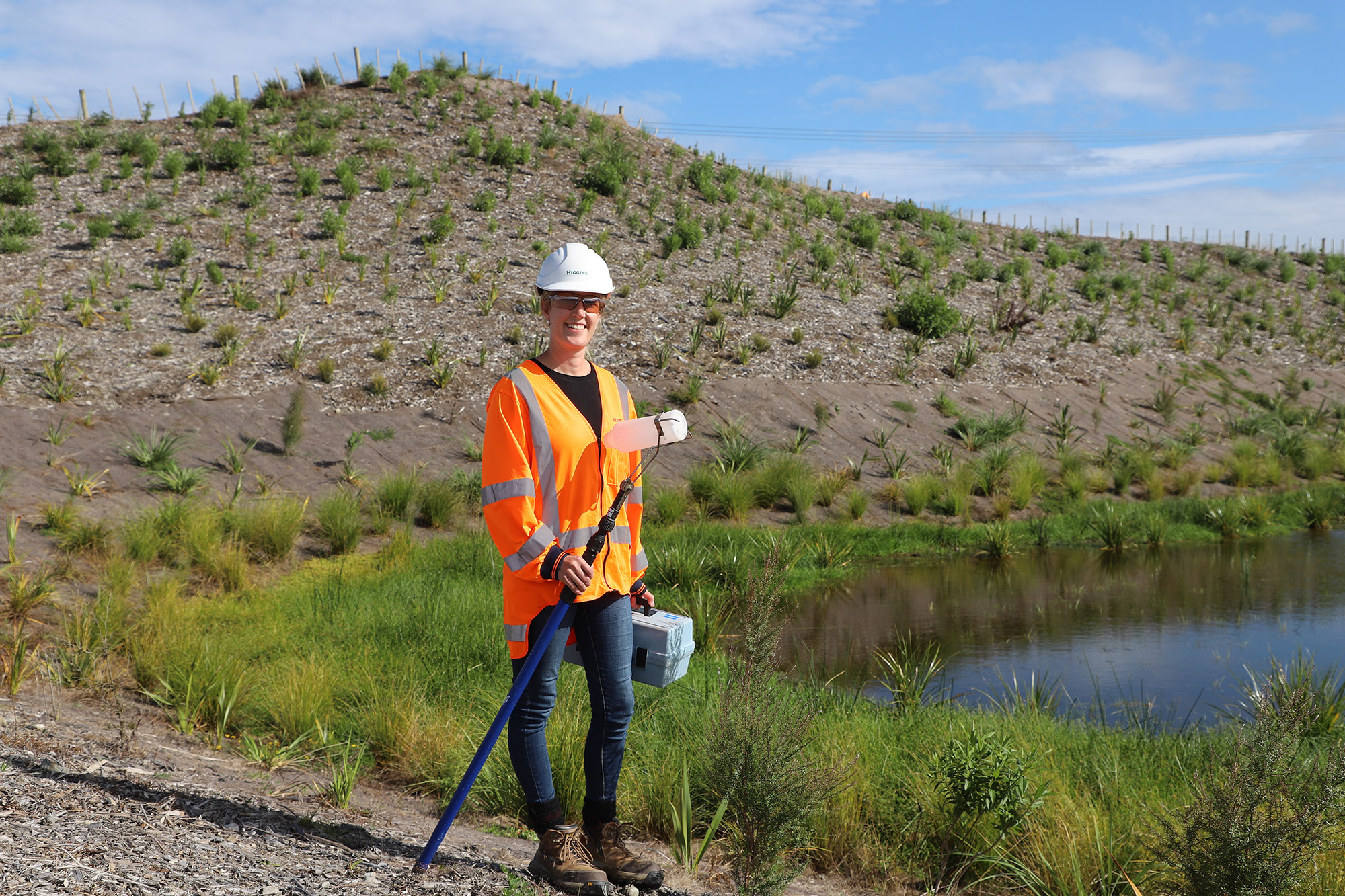
Alice Naylor out on site undertaking water testing.
There has been a lot in the news lately about the importance of wetlands, not just for local communities but New Zealand and the world as a whole. They have been described as the lungs of the world and their value during both droughts and floods as a filter and depository of water has been lauded.
This is why one of the key focuses at PP2Ō is ensuring that the wetlands surrounding the construction site are protected by all means possible. In fact we see that as a mark of our success.
“The general approach taken by the PP2Ō environmental team is to avoid disturbance of existing habitats where possible. If disturbance cannot be avoided, attempts are made to minimise the amount of disturbance,” Environmental Manager Alice Naylor says with passion.
“Where minor impacts are predicted, rehabilitation and restoration of the existing areas are implemented to ensure we protect the environment.”
She stresses that compensation for lost biodiversity is provided by mitigation planting to offset any impacts that the project might have.
Crucial locations for ecological restoration work along the PP2Ō expressway include Makahuri, the Ōtaki Railway Wetland, Jewell Stream, Mangaone Stream and the Te Horo native forest remnant.
There are a number of environmental activities that the PP2Ō project is particularly proud of.
Painstaking efforts were made prior to the unavoidable disturbance of some existing native bush areas, including surveying native lizards and silk worms, rescuing them and moving them to safe habitats outside of the project footprint. This was done in consultation with the Department of Conservation and local residents.
Native fish have also been rescued and relocated to ensure that the project had no impact on the native fish diversity and abundance within the local waterways. This is an ongoing activity to ensure the health of the waterways.
Additionally, native dotterels have been and are monitored on an ongoing basis, as the nesting habitat for this nationally vulnerable bird is within the project designation. Last year we watched over a nesting pair near the Ōtaki River Bridge site and diverted work away from the nests to ensure they weren’t disturbed.
New stream channels have been designed to mimic existing stream habitats where possible and are being enhanced with planting to improve shading and habitat.
The types of planting on the project are terrestrial, riparian, wetland, landscaping and visual, as well as river planting covering a total area of around 57 hectares.
At a time where environmental preservation is vital in New Zealand and the rest of the world, the PP2Ō project has truly maintained its focus by remaining in harmony with nature.
Bridge 8 – a job well done
It was hard not to notice that the spans for Bridge 8 were going up. After all, they traversed the Main Trunk Rail Line and SH1 at Hyde Park. So much can go wrong with these lifts if precision planning is not undertaken.
The project worked with KiwiRail to ensure the beam lifts over the main trunk line were carried out between scheduled train movements, which gave them a window of about an hour for each lift.
The lifts were undertaken in the middle of the night to lessen disruption to motorists as SH1 also had to be closed. Although a diversion was in place for light vehicles, trucks had up to 30 minute waits while the beams were lifted.
PP2Ō’s Bridge Man – Glenn Boyer and Bridge 1
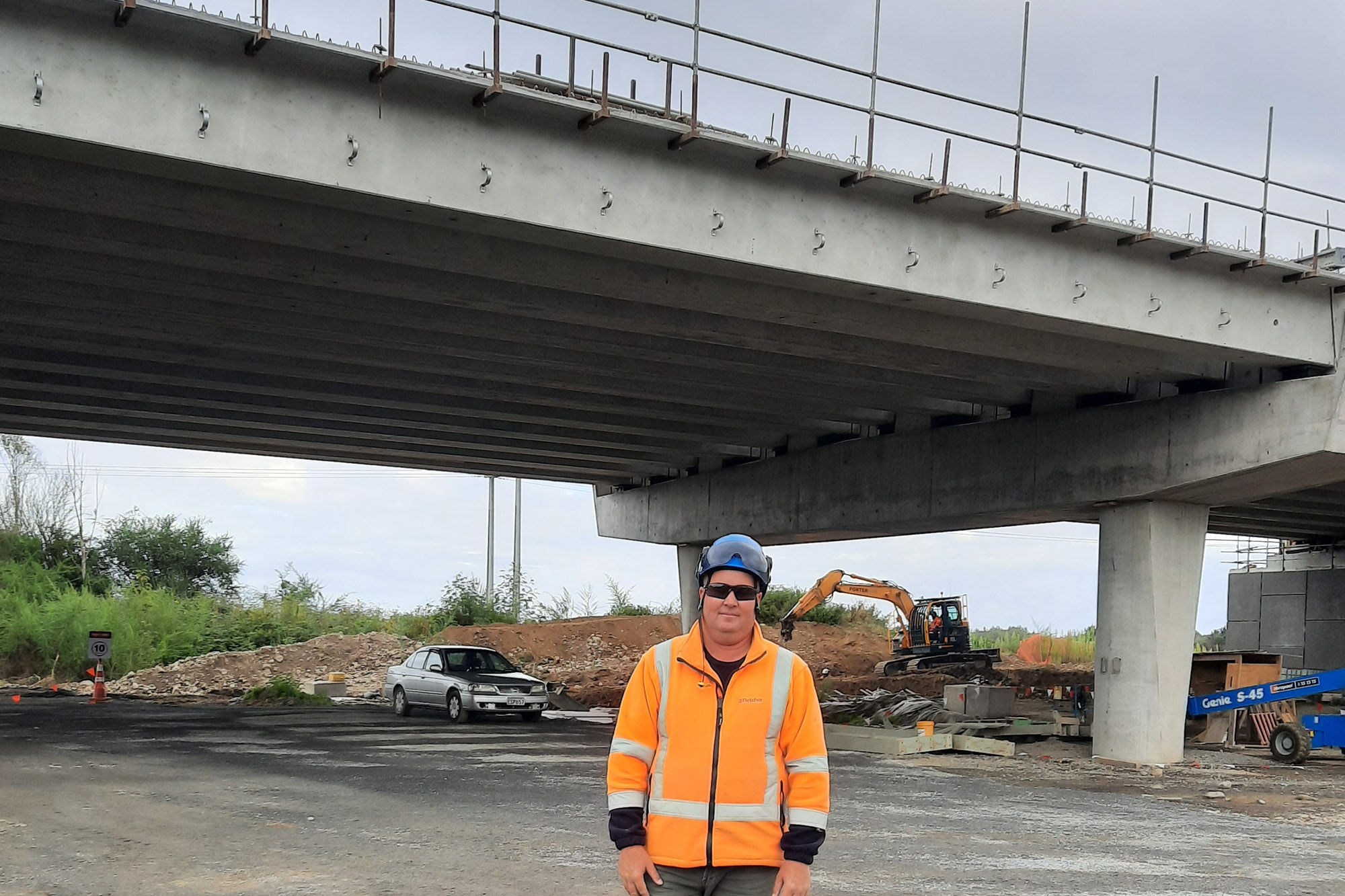
Glenn Boyer under Bridge 1.
Glenn Boyer, aka ‘The Bridge Man’, is a born and bred Bay of Plenty man who started his journey with Fletcher 26 years ago, initially as a labourer. He then progressed through a number of different roles, including apprentice and leading hand, to his current role as Bridge Supervisor. He is a key member of staff on the PP2Ō project.
As Bridge Supervisor, Glenn manages the construction of Bridge 1 and Bridge 5 on the PP2Ō project. Bridge 1 is in the north of the project over the Waitohu Stream by Taylors Road and Bridge 5 is the Ōtaki River Bridge.
A significant milestone was achieved on Tuesday 10 March, for Glenn and his team when the last of 177 “super Tee” structural beams was laid on Bridge 1.
When asked what was unique or particularly challenging about the construction of Bridge 1 and 5, Glenn referred to both bridges being constructed over waterways.
“Depending on the nature and extent of the waterways, this can bring its own level of challenge and opportunty to each build,” Glenn said.
Waitohu Stream, at the northern end of the project, is an ecologically significant stream within the area. It was diverted from its original course underneath Bridge 1 to enable work on drain lines and earthworks to be undertaken.
When completed, the stream will be reverted back to its original course, with every precaution taken to maintain the ecological values of the stream.
“Bridge 5, is constructed over the Ōtaki River. Ōtaki River is considered one of country’s fastest rising rivers and as such designated a potential flood hazard area.”
“Thankfully, this potential hazard has not had any major impact on the construction of Bridge 5 so far,” Glenn said.
“However, an awareness of the possible risk and readiness for how we might address the impact of future works on the site is still necessary.”
Construction vehicles are expected to access over Bridge 1 by September 2020 and Bridge 5 by October 2020.
Glenn takes great pride in ensuring that any environmental impacts of their work is minimised to ensure the integrity of the streams and rivers are, at a minimum, maintained in the same condition as they were prior to the work commencing and in some cases even improved over time. Glenn is proud of the work of his team does in this area. He says “I know the guys take pride in their work, and it shows.”
It should be noted that Glenn successfully watched over a nest that vulnerable Dotterels built on the shores of the Ōtaki River. He shifted work away from the area while the chicks hatched, fledged and left the nest, which show the extent of the responsibilities of a bridge man can be very diverse.
When Glenn is not managing the construction of bridges, he is doing house renovations or enjoying supporting his children’s many and varied sports events over the weekend. For Glenn, family is his priority and although he does enjoy the occassional swing of a golf club – and is apparently pretty good at it - time spent with his family comes first.
Upcoming construction milestones
North of Bridge 1, Taylors Road
We will carry out construction of Culvert 1 once work resumes after the lock-down. A temporary diversion will be installed in Greenwood Stream to divert the water in order to maintain its natural flow while the culvert which runs under the new expressway is constructed.
North of Ōtaki River and Bridge 1
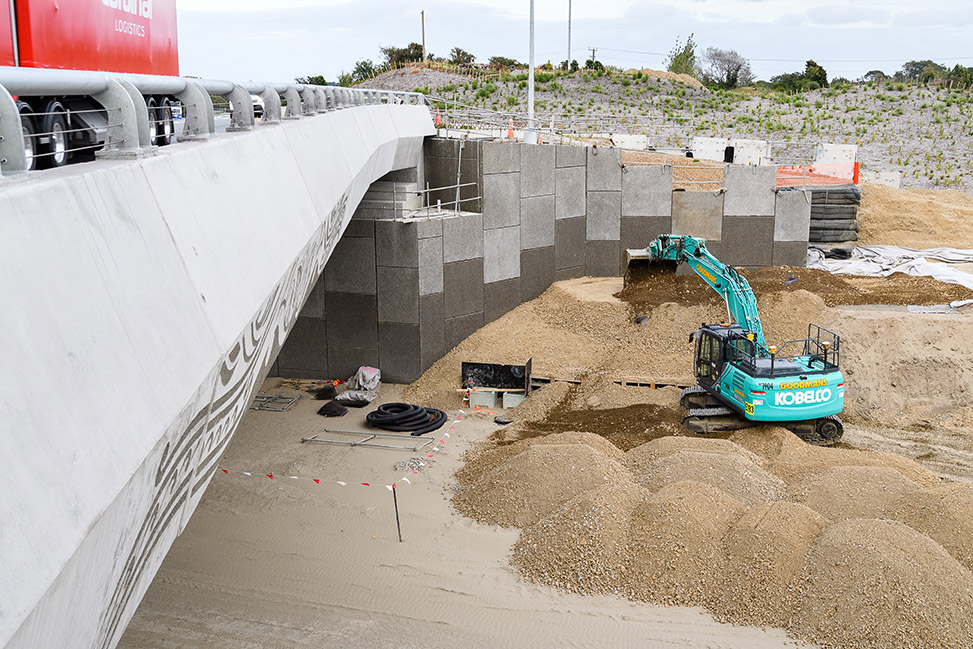
Work continues north of Bridge 1.
We will recommence earthworks and drainage work around the area north of the Ōtaki River up to Bridge 1.
Winstones Yard
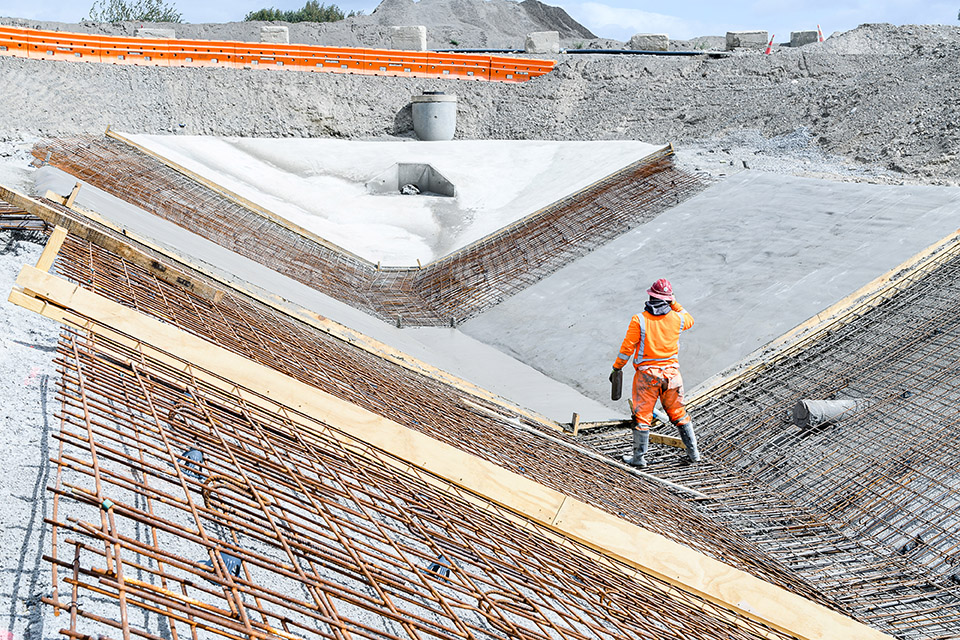
Work continues on the sediment ponds at Winstones yards.
Accommodation works at Winstone’s Quarry is recommencing as essential flood work. As soon as this work has been completed, PP2Ō will take ownership of the road next to the quarry, allowing us to complete work along Bridge 5.
Bridges 6 and 7
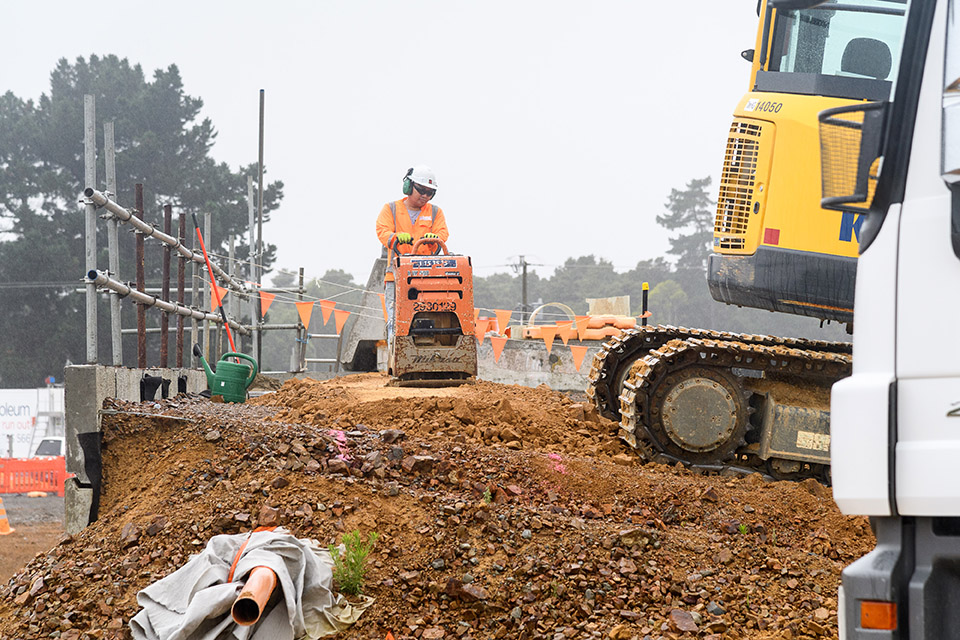
Placing the pavement aggregate.
Once work resumes, residents will quickly be able to see pleasing visual progress in this area. When we begin placing pavement aggregate on the first planned section of Ōtaki Gorge Road.
Bridge 8
We will recommence the abutment work around Bridge 8 now that we have the beams in place, which will allow us to finish this in time for winter planting, depending on how long the COVID-19 lock-down continues.
Bridge 9
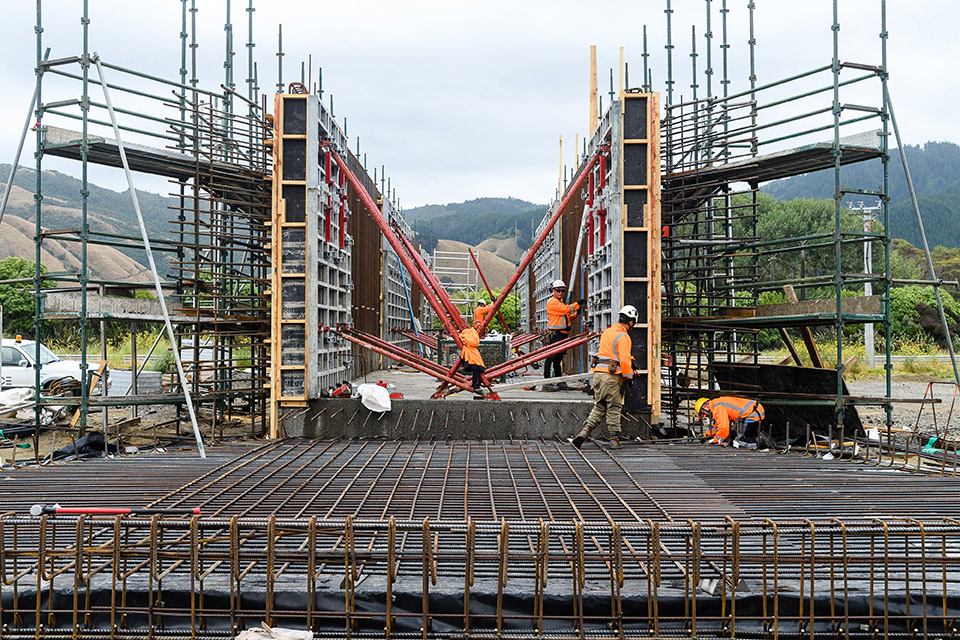
Hard at work on Bridge 9.
Plans are in place to finish the abutment around the west side of Bridge 9.
Local Arterial Road (LAR) stage 2
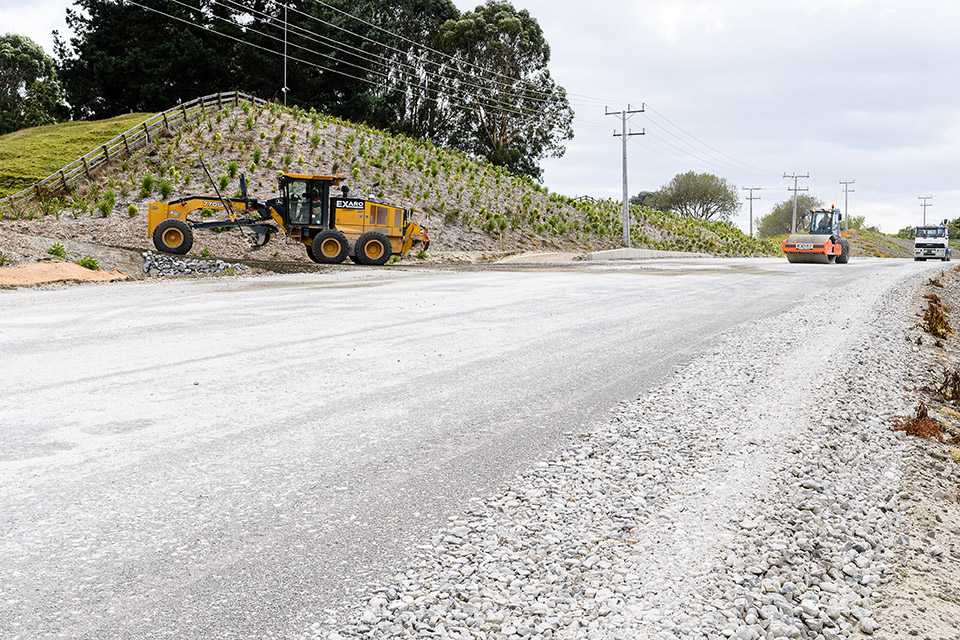
Stage 2 LAR takes shape.
Lastly, we will recommence the construction of the Local Arterial Road (Peka Peka to Marycrest) which we will refer to as LAR stage 2, once the COVID-19 lock-down is eased.